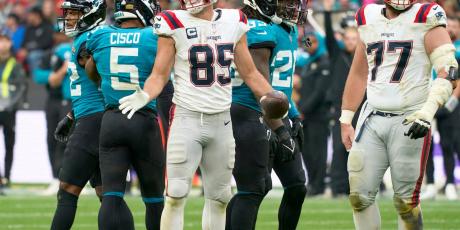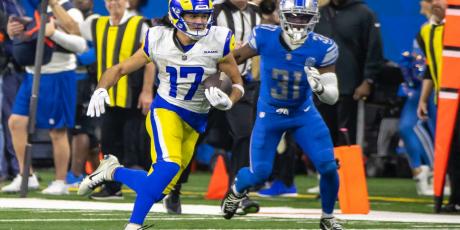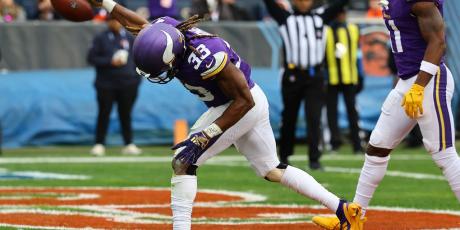Fantasy Football Strength of Schedule Beneficiaries: QBs

Matchups matter, as my neck tattoo reads, and they matter more for quarterbacks than any other position in fantasy football.
Why? Because quarterback points – like kicker, defense, and tight end – are replaceable, while elite running back and wide receiver production is largely not replaceable.
Quarterback replacebility is real, and it’s spectacular, with 20 signal callers notching at least five top-12 finishes in 2013. Thirty-seven quarterbacks posted QB1 (top-12) numbers at least twice last season. Stand still and let that wash over you.
And when we adjust for schedule, we see that the weakest secondaries become screaming targets for those who stream the quarterback position. It all adds up to a legitimate and growing case for the (very) late-round quarterback draft approach, and for streaming the position in traditional leagues. I'll be writing a weekly column again this season covering that very topic.
We’ve explored the most appealing schedules for tight ends, wide receivers, and running backs using 4for4’s nifty, new Strength of Schedule Ranking tool. Now it’s time to drill down into the softest signal caller slates for 2014, and how that might impact our approach to streaming the position.
It was only last year that my 4for4 streaming selections averaged 17.7 fantasy points per game, with optimal QBBWW plays averaging 23.1 points. Read the ink on my neck: Matchups matter. Below are five quarterbacks likely to benefit from an easy schedule in 2014.
Ryan Tannehill, MIA
Tannehill, who certainly had his usefulness in favorable matchups last season, hasn’t been on my QBBWW draft radar with so many superior options going after him (here’s looking at you, Carson Palmer).
It’s worth noting that no quarterback gets a softer slate in 2014. The Dolphins are expected to adopt the speed-huddle approach that worked pretty well in Philadelphia last season. Offensive coordinator Bill Lazor’s offense is expected to be decidedly run heavy, as Philly’s was in 2013.
Tannehill will face one unfavorable matchup all season – Week 7 at Chicago. I could see the Miami signal caller being a red-hot waiver wire pickup in September.
Tanny, in two years as a pro, hasn’t performed too much better against bottom-half pass defenses than top-half units, averaging 16 points per game against the NFL’s best coverage units and 18.2 points against the worst.
Jay Cutler, CHI
Cutler’s fantasy upside is now (partly) baked into his average draft position (QB14), so I’m not as gung-ho about ol’ Cutty this year as I was during his first offseason with Marc Trestman, the quarterback whisperer.
Cutler will face an almost ridiculously easy schedule in 2014; everything outside of Week 2 against the 49ers and Week 5 at Carolina looks like all-systems-go for Cutler. Remember that Cutler and backup Josh McCown combined for the third most quarterback fantasy points during Trestman’s first season at the helm. Top-5 numbers are firmly in Cutler’s range of outcomes.
Bears coaches say they’ve seen “extraordinary progress” this offseason from the veteran signal caller. A mostly-easy schedule feeds the argument that Cutler could well exceed his current ADP.
Jake Locker, TEN
Locker’s rushing prowess is really the only thing that makes him a viable streaming option, and with the Titans’ coaching staff determined to make him more of a consistent pocket passer, I think his fantasy usefulness could be dead on arrival come September.
Locker posted a decent fantasy points per attempt (FPAT) during his injury-shortened 2013 campaign, posting .42 points every time he chucked the rock. He was tied with none other than Tom Brady and Andrew Luck in FPAT. Locker posted a better FPAT than Carson Palmer. If Locker throws somewhere around 550 passes at that .42 FPAT clip, I think he has top-12 potential.
(I’ll get into FPAT in August when I begin my Quarterback By Waiver Wire series)
Locker, during his best three-game stretch of 2013, averaged 258 passing yards, two passing scores, and 38 rushing yard per game. He’ll have just two difficult matchups in what has been termed a “make or break” season for young quarterback.
Eli Manning, NYG
I don’t see a compelling reason to roll with Eli in his first year in Ben McAdoo’s system – a system that, according to observers, could hardly be more different than the one run by deposed Big Blue offensive coordinator Kevin Gilbride.
Manning will have a fantastic schedule though, with five good or great matchups to go along with a handful and a half of neutral matchups. That doesn’t change the fact that he could be a horrendous match for McAdoo’s offense, and that he saw jaw-dropping statistical regression in 2013.
Eli’s 2013 fantasy efficiency was Henne-esque.
Eli will likely have his highest QBBWW value in Weeks 4-7, when the Giants face off against some of the league’s worst coverage units. Don’t dismiss the lesser Manning as a non-option in 2014.
Ryan Fitzpatrick, HOU
Only one quarterback, Tannehill, has an easier schedule than Fitzpatrick as he takes the reins of a Houston offense that couldn’t have been worse in 2013.
It’s expected to be a (very) run heavy, conservative approach, but that doesn’t mean Fitzpatrick won’t have his usefulness in 2014. He has a mostly mouth-watering first five games, defenses will be forced to respect the Texans’ running attack, and one of the game’s best pass catchers (Andre Johnson) will be gobbling up targets throughout the season.
Fitzy’s 2013 FPAT of .40 is pretty ugly, though his .43 FPAT in 2012 should give us some hope that he can put up fantasy points if given the opportunity. Fitzpatrick also offers a rushing boost. Almost 11 percent of his 2012 fantasy points came on the ground – a hefty number for a quarterback – while an amazing 22.2 percent of his 2013 fantasy production came via his shifty feet.
Fitzpatrick could very well join Tannehill as hot QBBWW commodities during the first half of the season.






















